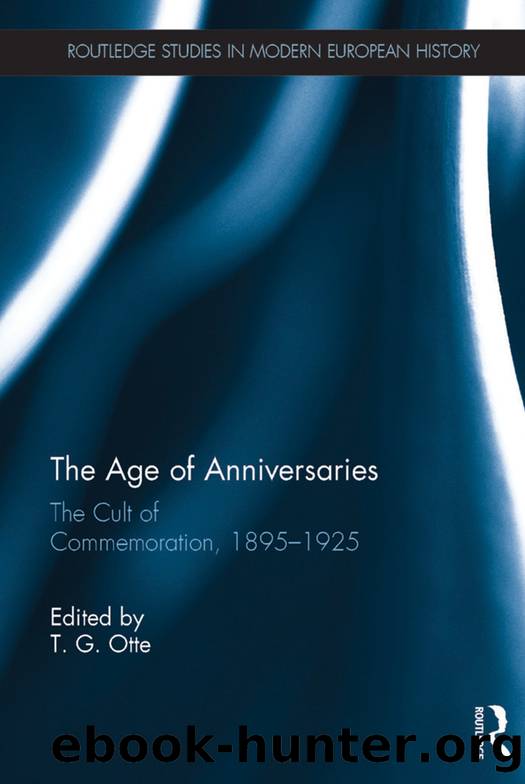The Age of Anniversaries by T. G. Otte

Author:T. G. Otte
Language: eng
Format: epub
Publisher: Taylor & Francis (CAM)
Published: 2018-11-15T00:00:00+00:00
Bessarabia, 1912: nationalism and mobilization on the imperial periphery
In the aftermath of the Russo-Turkish War (1806â1812), eastern territories from the Principality of Moldovia had been ceded by the Ottoman Empire to Russia following the Peace of Bucharest: these lands became known as the Governorate of Bessarabia. A series of festivals were held in Bessarabia during mid-1912 in celebration of this event. Considering first the social context of Bessarabia, according to the most reliable and comprehensive set of data available, the 1897 imperial census, the capital city of Bessarabia of Kishinev (or Chisinau in Romanian) had a total population of 108,500 in 1897, which had grown to 116,500 by 1913.52 Bessarabiaâs economy was much more agrarian than that of St. Petersburg, Moscow or other areas to the southwest of the empire, such as Kiev or Odessa. In contrast to an increasing proportion of European Russiaâs inhabitants who had become factory workers and tradesmen, Kishinevâs residents were often employed in rural industries such as farming and food production: this was the case even late in the nineteenth century after Sergei Witteâs industrialization projects had transformed large parts of the empire over the previous decade. Heavy industries such as metalworking were increasingly present in Kishinev but still accounted for a relatively small percentage of the total economy of the Bessarabia region.53
In respect to its social and confessional basis, there were significant concentrations of non-Russian nationalities and religious minorities in Bessarabia. Like in Poltava, those Russian by nationality â as the census described them â were in a distinct minority in Kishinev and the surrounding region.54 They were also under-represented in Bessarabia province as a whole. Significantly there was a strong Jewish presence: the census listed nearly half of the townsfolk (45 per cent) as Jewish.55 In Kishinev, scene of a notorious and destructive pogrom in 1903, Jews were disproportionately involved in the townâs mercantile and commercial industries, a feature all the more pronounced given the generally low proportion of townsfolk involved in these occupations.56 In addition to the strong presence of Jewish religion and the economic success of the Jewish community, there was a prominent Romanian population in the area.57 Many Russian Orthodox believers had been incorporated into the enlarged territory following Russiaâs victory over Turkey, and this fact would play a central role in the centennial anniversary celebrations.
Bessarabia was an area marked by poverty and social tensions. After the ferocious and destructive anti-Jewish riots of 1903, the radical right established a strong presence in Bessarabia and was active in ceremonials held through May and June 1912.58 This included the local branch of one of the largest right-wing groups in the late imperial period, the Union of the Archangel Mikhail (UAM). By then, some on the radical right had become part of the political establishment that they sought to denigrate. These included the leader of the Bessarabia branch of the UAM and the delegate to the Third and Fourth State Dumas from Bessarabia, Vladimir Purishkevich. One of his most notable associates in the
Download
This site does not store any files on its server. We only index and link to content provided by other sites. Please contact the content providers to delete copyright contents if any and email us, we'll remove relevant links or contents immediately.
| Africa | Americas |
| Arctic & Antarctica | Asia |
| Australia & Oceania | Europe |
| Middle East | Russia |
| United States | World |
| Ancient Civilizations | Military |
| Historical Study & Educational Resources |
Machine Learning at Scale with H2O by Gregory Keys | David Whiting(4200)
Never by Ken Follett(3801)
Fairy Tale by Stephen King(3233)
The Man Who Died Twice by Richard Osman(2998)
Oathbringer (The Stormlight Archive, Book 3) by Brandon Sanderson(2907)
Will by Will Smith(2797)
Rationality by Steven Pinker(2295)
The Dark Hours by Michael Connelly(2246)
Can't Hurt Me: Master Your Mind and Defy the Odds - Clean Edition by David Goggins(2230)
Friends, Lovers, and the Big Terrible Thing by Matthew Perry(2127)
The Dawn of Everything: A New History of Humanity by David Graeber & David Wengrow(2124)
Principles for Dealing With the Changing World Order: Why Nations Succeed and Fail by Ray Dalio(1975)
HBR's 10 Must Reads 2022 by Harvard Business Review(1782)
A Short History of War by Jeremy Black(1764)
Go Tell the Bees That I Am Gone by Diana Gabaldon(1691)
515945210 by Unknown(1603)
A Game of Thrones (The Illustrated Edition) by George R. R. Martin(1597)
Kingdom of Ash by Maas Sarah J(1538)
443319537 by Unknown(1473)
